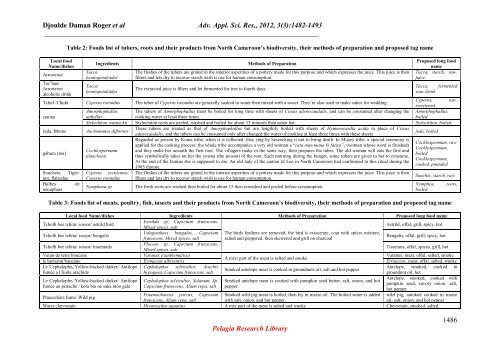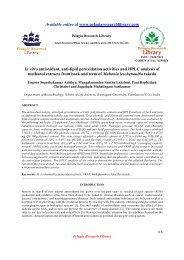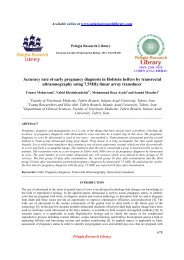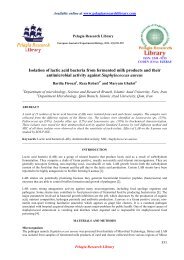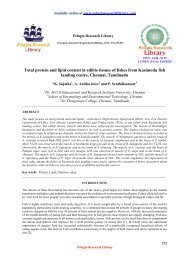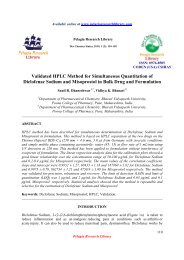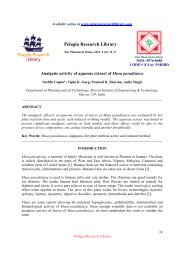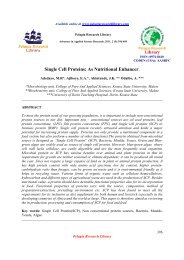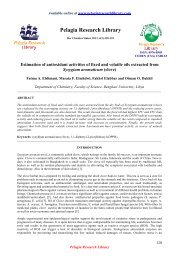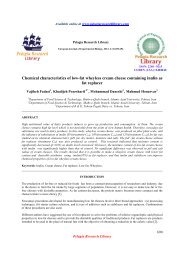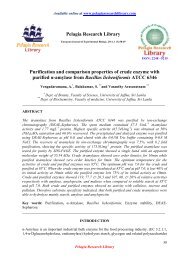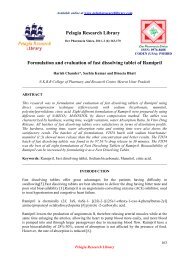Nutritional properties of “Bush Meals” - Pelagia Research Library
Nutritional properties of “Bush Meals” - Pelagia Research Library
Nutritional properties of “Bush Meals” - Pelagia Research Library
You also want an ePaper? Increase the reach of your titles
YUMPU automatically turns print PDFs into web optimized ePapers that Google loves.
Djoulde Daman Roger et al Adv. Appl. Sci. Res., 2012, 3(3):1482-1493<br />
_____________________________________________________________________________<br />
Local food<br />
Name/dishes<br />
Arrowroot<br />
Tac’haa/<br />
Arrowroot<br />
alcoholic drink<br />
Table 2: Foods list <strong>of</strong> tubers, roots and their products from North Cameroon’s biodiversity, their methods <strong>of</strong> preparation and proposed tag name<br />
Ingredients<br />
Tacca<br />
leontopetaloides<br />
Tacca<br />
leontopetaloides<br />
Methods <strong>of</strong> Preparation<br />
The fleshes <strong>of</strong> the tubers are grated in the interior asperities <strong>of</strong> a pottery made for this purpose and which expresses the juice. This juice is then<br />
filters and lets dry to recover starch wish is use for human consumption.<br />
The extracted juice is filters and let fermented for tree to fourth days.<br />
Proposed long food<br />
name<br />
Tacca, starch, raw,<br />
juice<br />
Tacca, fermented<br />
sour drink<br />
Tchuf /Chufa Cyperus rotondus The tuber <strong>of</strong> Cyperus rotondus are generally soaked in water then mixed with a sweet. They’re also used to make cakes for wedding.<br />
Cyperus, raw,<br />
sweetened<br />
zanina<br />
Amorphophallus<br />
aphyllus<br />
The tubers <strong>of</strong> Amorphophallus must be boiled for long time with sheets <strong>of</strong> Cissus adenocaudalis, and can be consumed after changing the<br />
cooking water at least three times<br />
Amorphophallus,<br />
boiled<br />
Stylochiton warneckii Stylochiton roots are peeled, washed and boiled for about 15 minutes then eaten hot. Stylochiton, boiled<br />
Jeda, Blume Anchomanes difformis<br />
These tubers are treated as that <strong>of</strong> Amorphophallus but are lengthily boiled with sheets <strong>of</strong> Hymenocardia acida in place <strong>of</strong> Cissus<br />
adenocaudalis, and the tubers can be consumed only after changed the water <strong>of</strong> cooking at least three times with these sheets<br />
jeda, boiled<br />
gabura (ma)<br />
Regarded as poison by Koma tribe, when it is collected, they sing by beseeching it not to bring death. In Muzey tribe, a special ceremony is<br />
Cochlospermum, raw<br />
applied for the cooking process: the whole tribe accompanies a very old woman a “cata man mana ki fatiya”, (woman whose word is finished)<br />
Cochlospermum,<br />
Cochlospermum and they make her unearth the first root. The villagers make in the same way, then prepares the tuber. The old woman will eats the first and<br />
boiled<br />
planchonii<br />
thus symbolically takes on her the yowna (the poison) <strong>of</strong> the root. Each morning during the hunger, some tubers are given to her to consume.<br />
Cochlospermum,<br />
At the end <strong>of</strong> the famine she is supposed to die. An old lady <strong>of</strong> the canton <strong>of</strong> Leo in North Cameroon had conformed to this ritual during the<br />
cooked, pounded<br />
1985 famine.<br />
Souchets, Tigernut,<br />
flatsedge<br />
Bulbes de<br />
nénuphars<br />
Cyperus esculentus,<br />
Cyperus rotondus<br />
Nymphaea sp<br />
The fleshes <strong>of</strong> the tubers are grated in the interior asperities <strong>of</strong> a pottery made for this purpose and which expresses the juice. This juice is then<br />
filters and lets dry to recover starch wish is use for human consumption.<br />
The fresh roots are washed then boiled for about 15 then rewashed and peeled before consumption<br />
Souchet, starch, raw<br />
Nymphea,<br />
boiled<br />
Table 3: Foods list <strong>of</strong> meats, poultry, fish, insects and their products from North Cameroon’s biodiversity, their methods <strong>of</strong> preparation and proposed tag name<br />
Local food Name/dishes Ingredients Methods <strong>of</strong> Preparation Proposed long food name<br />
Tcholli bee tchita/ sossor/ astrild bird<br />
Estrilda sp, Capscium frutescens,<br />
Mixed spices, salt<br />
Astrild, <strong>of</strong>fal, grill, spicy, hot<br />
Tcholli bee tchita/ sossor/ bengalis<br />
Udagenthuss bengalus, Capscium The birds feathers are removed, the bird is eviscerate, coat with spices mixture,<br />
frutescens, Mixed spices, salt<br />
salted and peppered, then skewered and grill on charcoal<br />
Bengalis, <strong>of</strong>fal, grill, spicy, hot<br />
Tcholli bee tchita/ sossor/ tisserands<br />
Ploceus sp, Capscium frutescens,<br />
Mixed spices, salt<br />
Tisserans, <strong>of</strong>fal, spices, grill, hot<br />
Varan de terre boucane<br />
Varanus exanthematicus<br />
Varanus, meat, <strong>of</strong>fal, salted, smoke<br />
A mixt part <strong>of</strong> the meat is salted and smoke<br />
le hérisson boucane Erinaceus albiventris Erinaceus, meat, <strong>of</strong>fal, salted, smoke<br />
Le Cephalophe,/Yellow-backed duiker/ Antilope Cephalophus sylvicultor, Arachis<br />
Antelope, smoked, cooked in<br />
Smoked antelope meat is cooked in groundnuts oil, salt and hot pepper<br />
fumée a l’huile arachide<br />
hypogaea, Capscium frutescens, salt<br />
groundnut oil, hot<br />
Antelope, smoked, cooked with<br />
Le Cephalophe,/Yellow-backed duiker/ Antilope Cephalophus sylvicultor, Solanum. Sp, Smoked antelope meat is cooked with pumpkin seed butter, salt, onion, and hot<br />
pumpkin seed, savory onion, salt,<br />
fumée au pistache / kora bia nê saka môo gala Capscium frutescens, Alium cepa, salt pepper.<br />
hot pepper<br />
Phacochère fume/ Wild pig<br />
Potamochoerus porcus, Capscium Smoked wild pig meat is boiled, then fry in maize oil. The boiled water is added wild pig, smoked cooked in maize<br />
frutescens, Alium cepa, salt<br />
with salt, onion, and hot pepper.<br />
oil, salt, onion, and hot pepper<br />
Water chevrotain Hyemoschus aquatius A mix part <strong>of</strong> the meat is salted and smoke Chevrotain, smoked, salted<br />
roots,<br />
<strong>Pelagia</strong> <strong>Research</strong> <strong>Library</strong><br />
1486


